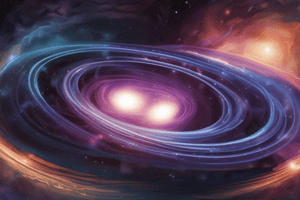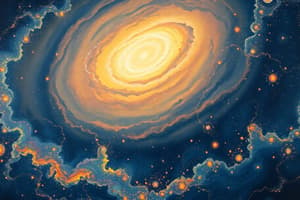Podcast
Questions and Answers
What distinguishes irregular galaxies from elliptical and spiral galaxies?
What distinguishes irregular galaxies from elliptical and spiral galaxies?
- Formation from collisions with other galaxies
- Contain older, dimmer stars
- Presence of interstellar gases
- Lack of a distinct shape (correct)
Which galaxy type contains a combination of old and young stars?
Which galaxy type contains a combination of old and young stars?
- Spiral galaxies
- Elliptical galaxies
- Irregular galaxies (correct)
- None of the above
What is a key characteristic that distinguishes elliptical galaxies from spiral galaxies?
What is a key characteristic that distinguishes elliptical galaxies from spiral galaxies?
- Spherical or cucumber-like shape (correct)
- Combination of old and young stars
- Central disk surrounded by spiral arms
- Presence of interstellar gases
Which type of galaxy is most likely to be a solar nursery?
Which type of galaxy is most likely to be a solar nursery?
What sets irregular galaxies apart in terms of stellar composition?
What sets irregular galaxies apart in terms of stellar composition?
In terms of dust content, how do irregular galaxies compare to elliptical galaxies?
In terms of dust content, how do irregular galaxies compare to elliptical galaxies?
What type of galaxy is characterized by a lack of a distinct shape?
What type of galaxy is characterized by a lack of a distinct shape?
What is a key characteristic of irregular galaxies in terms of interstellar gases?
What is a key characteristic of irregular galaxies in terms of interstellar gases?
How are elliptical galaxies different from spiral galaxies in terms of star composition?
How are elliptical galaxies different from spiral galaxies in terms of star composition?
What contributes to the lack of a distinct shape in irregular galaxies?
What contributes to the lack of a distinct shape in irregular galaxies?
Which type of galaxy is most likely to be satellite galaxies formed from collisions with other galaxies?
Which type of galaxy is most likely to be satellite galaxies formed from collisions with other galaxies?
What distinguishes irregular galaxies from elliptical and spiral galaxies in terms of shape?
What distinguishes irregular galaxies from elliptical and spiral galaxies in terms of shape?
How do irregular galaxies compare to elliptical and spiral galaxies in terms of dust content?
How do irregular galaxies compare to elliptical and spiral galaxies in terms of dust content?
Why do irregular galaxies possess both old and young stars?
Why do irregular galaxies possess both old and young stars?
What makes spiral galaxies different from elliptical and irregular galaxies?
What makes spiral galaxies different from elliptical and irregular galaxies?
In terms of stellar composition, what is a distinguishing feature between elliptical and irregular galaxies?
In terms of stellar composition, what is a distinguishing feature between elliptical and irregular galaxies?
'NGC 1592' mentioned in the text is an example of which type of galaxy?
'NGC 1592' mentioned in the text is an example of which type of galaxy?
Flashcards are hidden until you start studying
Study Notes
Understanding Galaxies
- A galaxy is a vast collection of stars, planets, nebulae, gases, dust, and cosmic matter held together by gravity.
- Over 200 billion galaxies exist in the universe, as estimated by astronomers utilizing advanced telescopes.
- Galaxies vary significantly in size, spanning from a few light-years to hundreds of thousands of light-years in diameter. One light-year equals about 5.8 trillion miles or 9.4 trillion kilometers.
Galaxy Formation
- Galaxies likely originate from clouds of dust and other cosmic matter that rotate and form a protogalaxy due to increased density and gravitational attraction.
- The spinning protogalaxy leads to density fluctuations, forming solar nebulae or protostars, ultimately contributing to solar system formation.
- The solar nebular theory explains how gravitational forces shape matter into a flattened disk that condenses to form stars, with remaining material forming planets and satellites.
Types of Galaxies
- There are three main types of galaxies: elliptical, spiral, and irregular, differentiated by their shapes and structures.
Elliptical Galaxies
- Elliptical galaxies are among the oldest and most evolved, making up about 33% of all galaxies.
- They have a spherical or cucumber-like shape, formed mainly by mature stars that have exhausted available dust and gas.
- Stars in elliptical galaxies exhibit random orbits, leading to low levels of dust and gas, often appearing dim.
- The uniform light emitted from elliptical galaxies can create an optical illusion, making them resemble a single giant star.
- Some elliptical galaxies may contain black holes at their centers, contributing to the absence of gas and dust.
Spiral Galaxies
- Spiral galaxies have a distinct shape, featuring a central disk with arms extending outward, resembling a pinwheel or sea star.
- Two subtypes exist: normal spiral galaxies and barred spiral galaxies, with the latter featuring a central bar of stars.
- The Milky Way is classified as a spiral galaxy, representing active star formation and youth compared to elliptical galaxies.
- Approximately 60% of galaxies are spiral, serving as homes to the majority of the universe's stars.
Studying That Suits You
Use AI to generate personalized quizzes and flashcards to suit your learning preferences.




